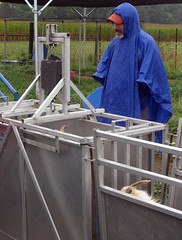Anthelmintic resistance is a worldwide problem. Targeted selective treatment is advocated as a means to increase the number of anthelmintic-susceptible genes in the parasite population.
 Teladorsagia circumcinta (brown stomach worm) is the most prevalent parasite in the United Kingdom. Its first signs of infection are anorexia and weight loss.
Teladorsagia circumcinta (brown stomach worm) is the most prevalent parasite in the United Kingdom. Its first signs of infection are anorexia and weight loss.
In a study to evaluate the effectiveness of targeted selective treatment, Moredun scientists in Scotland repeatedly weighed lambs to determine their need for deworming.A lamb's potential weight gain over a specified period was calculated. If a lamb did not reach its targeted weight, it was dewormed with a broad-spectrum anthelmintic.
Experimental field trials conducted over a period of four years showed that this targeted selective treatment approach halved the number of anthelmintic treatments compared to whole-group monthly treatments, while maintaining weight gain. The targeted selective treatment approach maintained the efficacy of ivermectin at 95%, whereas monthly whole-flock treatments reduced efficacy from 95% to 79% after 3 years.
In a pilot study on a commercial farm, only 20 percent of 85 lambs required anthelmintic treatment. The lambs that had been identified as not needing treatment gained 4.4 lbs. in a two week period, whereas those identified in need of treatment lost 1.8 lbs.
Read full article from Quality Meat Scotland
Editor's note: when and where the barber pole worm (Haemonchus contortus) is the primary parasite, FAMACHA© scores can be used to determine which animals require deworming.
 Teladorsagia circumcinta (brown stomach worm) is the most prevalent parasite in the United Kingdom. Its first signs of infection are anorexia and weight loss.
Teladorsagia circumcinta (brown stomach worm) is the most prevalent parasite in the United Kingdom. Its first signs of infection are anorexia and weight loss.In a study to evaluate the effectiveness of targeted selective treatment, Moredun scientists in Scotland repeatedly weighed lambs to determine their need for deworming.A lamb's potential weight gain over a specified period was calculated. If a lamb did not reach its targeted weight, it was dewormed with a broad-spectrum anthelmintic.
Experimental field trials conducted over a period of four years showed that this targeted selective treatment approach halved the number of anthelmintic treatments compared to whole-group monthly treatments, while maintaining weight gain. The targeted selective treatment approach maintained the efficacy of ivermectin at 95%, whereas monthly whole-flock treatments reduced efficacy from 95% to 79% after 3 years.
In a pilot study on a commercial farm, only 20 percent of 85 lambs required anthelmintic treatment. The lambs that had been identified as not needing treatment gained 4.4 lbs. in a two week period, whereas those identified in need of treatment lost 1.8 lbs.
Read full article from Quality Meat Scotland
Editor's note: when and where the barber pole worm (Haemonchus contortus) is the primary parasite, FAMACHA© scores can be used to determine which animals require deworming.

No comments:
Post a Comment